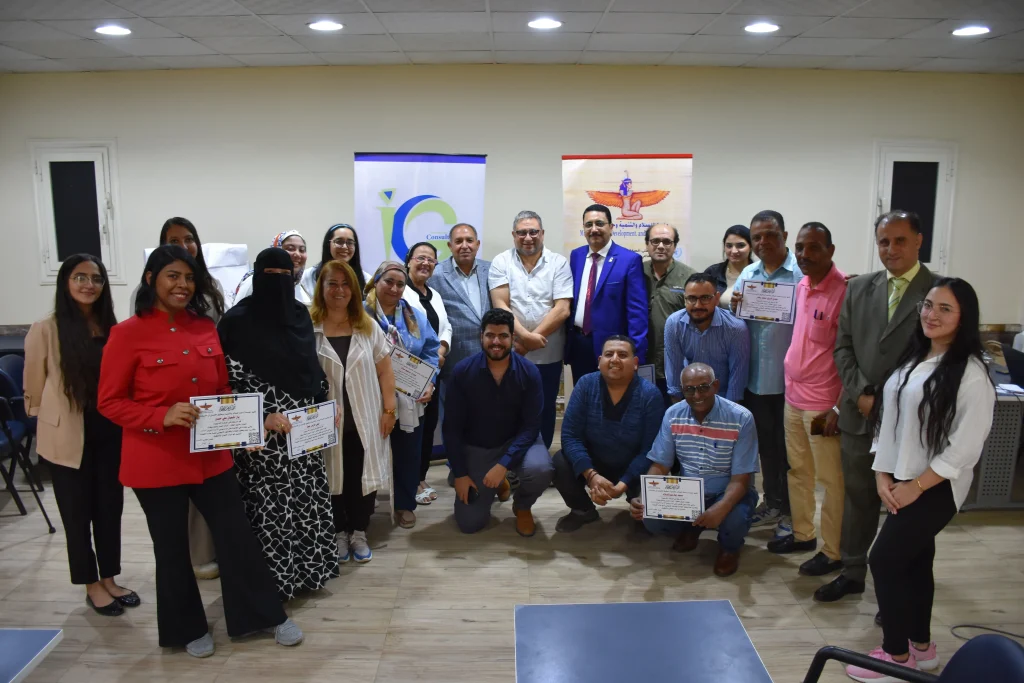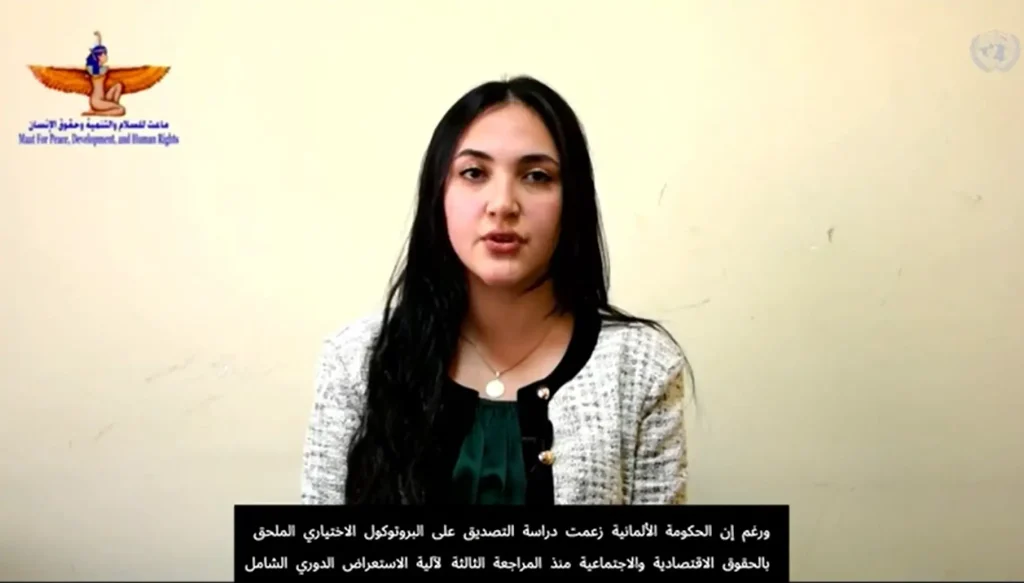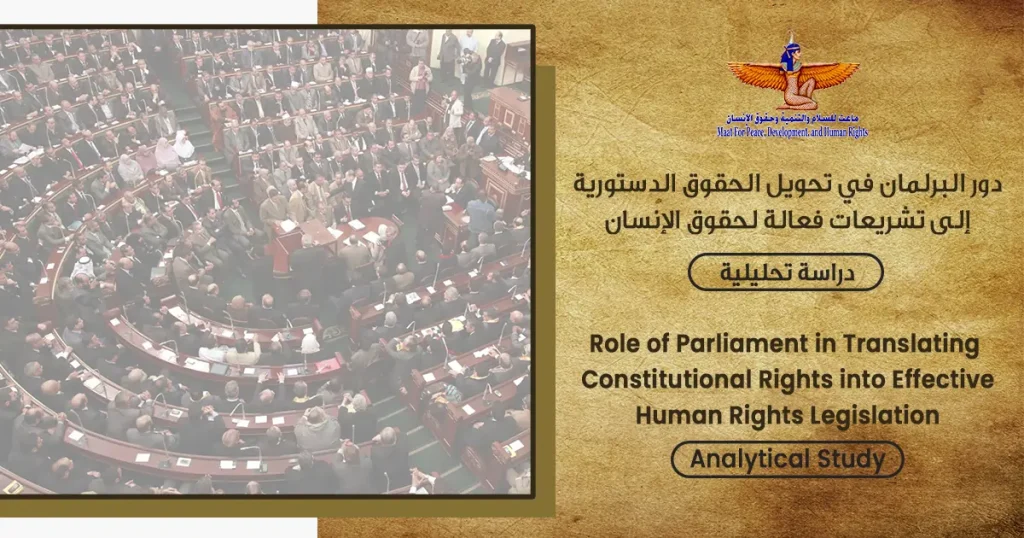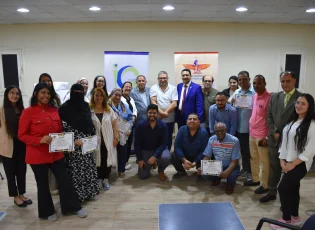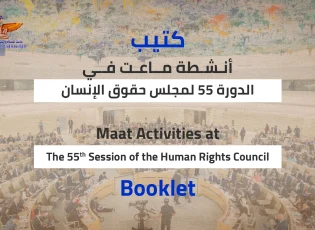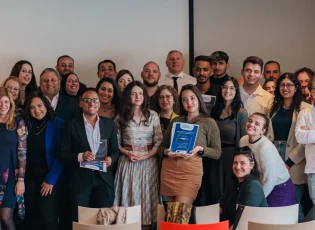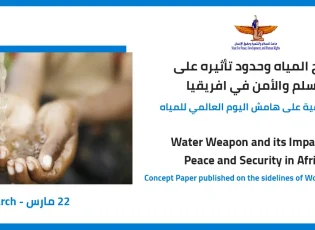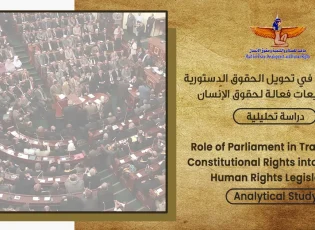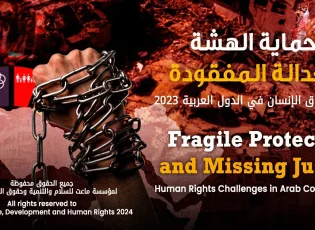"Trafficking in women ... Characterization and a vision for bridging legislative gaps"
Policy Paper
Issued it
Public Policy Analysis and Human Rights Unit
Affiliate Foundation
, Maat for Peace, Development, and Human Rights
Under a project
The Universal Periodic Review as a Tool to Improve Public Policies during the Transition
February 2017
“This release was implemented with the help of the European Union. The content of this publication is the responsibility of the Maat Foundation for Peace, Development and Human Rights and can in no way be considered a reflection of the vision of the European Union.
Introduction:
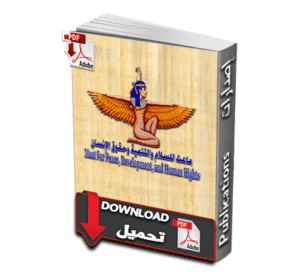 Human trafficking is the new old manifestation that violates human rights, which strikes the human dignity at its roots and is a stain on the forehead of the international community, and women and children are the most vulnerable to the process of trafficking, as the World Report on Trafficking in Persons issued by the United Nations Office on Drugs and Crime indicates that Women and girls make up about 70 1TTP1T victims of human trafficking, which confirms the failure of global efforts to address this phenomenon and requires more international cooperation to overcome it.
Human trafficking is the new old manifestation that violates human rights, which strikes the human dignity at its roots and is a stain on the forehead of the international community, and women and children are the most vulnerable to the process of trafficking, as the World Report on Trafficking in Persons issued by the United Nations Office on Drugs and Crime indicates that Women and girls make up about 70 1TTP1T victims of human trafficking, which confirms the failure of global efforts to address this phenomenon and requires more international cooperation to overcome it.
In light of the interest of an institution Maat for peace, development and human rights To follow up on the Egyptian government's commitments to its international obligations in the field of combating human trafficking, in light of its project The Universal Periodic Review as a Tool to Improve Public Policies during the TransitionThe Foundation presents this paper to try to work on presenting legislative and procedural proposals to work to address and combat the phenomenon of trafficking in women in Egypt.
This paper deals with the issue through a number of axes, the first of which is the historical context of the phenomenon of trafficking in women, and the second axis deals with the phenomenon of trafficking in women in Egypt, then the constitutional framework and international obligations in the context of dealing with the phenomenon of trafficking in women, as well as the causes of the spread of the phenomenon, and finally, the paper deals with a vision A proposal to work on curbing the phenomenon of trafficking in women in Egypt and trying to provide advice to policy makers to work on tackling this phenomenon.
The first axis: Women and human trafficking
First: A historical overview of the suffering of women from the phenomenon of trafficking in them
The problem of human trafficking, especially in women, is not a product of recent years. Rather, it is a very old and deep problem. It is known that it prevailed in pre-Christian times. The base of the strong controls the weak and from here the roots of the problem began and people divided into masters and slaves, which led to the emergence of trade Slaves in the sixteenth and seventeenth centuries, especially among women and children, given that they are the weakest element in society, and at that time the problem of human trafficking in the slave trade was known, and the slave trade and images of their hideous exploitation spread to the United States of America and to many Western countries, and the situation continued as such until it appeared Movements against racism, slavery and the exploitation of human beings of all kinds during the past three centuries.
Despite the emergence of these movements against slavery and slavery, the problem of human trafficking, especially between women and children, did not end. Rather, it was growing more and more, but in secret, which made it worse than it was in the Middle Ages until it reached what it is today despite the spread The principles of freedom and equality guaranteed by laws, whether international or internal to some countries, and the criminalization of international and domestic laws in some countries for the phenomenon of human trafficking, especially between women and children.[1].
Second: The most common forms of trafficking in women
The images and manifestations of trafficking in women are numerous, and cannot be limited to due to technical development and scientific progress, as they separate many images and manifestations of trafficking and exploitation, which were neither familiar nor expected with the concepts of the present time, and the patterns of this crime can be identified as follows: [2]:
- Trafficking in women for sexual purposes: where they are forced to engage in commercial sex by force, deception and coercion, or through the exercise of power and influence over the person who was forced to do such acts if he had not reached the age of eighteen. The involvement of criminal gangs in trafficking in women for the purpose of sexual exploitation increases because of the high profits achieved by this trade, which may be estimated in the hundreds of millions of dollars, as well as because of the difficulty in discovering their matter, and the light penalties that are applied to them in the event of arrest due to the weakness of the laws that apply in these cases.
- Trafficking in women for the purpose of forced labor and slavery: There are many forms of this form of human trafficking, as it may take the form of forced labor or forced servitude and forced labor, in addition to involuntary domestic servitude where domestic servants fall into slavery through the use of force or coercion, Or physical or psychological abuse.
Third: The human rights system deals with the issue of trafficking in women
The great danger and negative effects resulting from the phenomenon of human trafficking, especially among women, forced the international community to work to address this phenomenon and work to combat it, and many international agreements have emerged that work to address this phenomenon, and among the most prominent of these international agreements are the following: :
- Universal Declaration of Human Rights: The United Nations is committed to supporting, promoting and protecting the human rights of everyone, and this commitment stems from the United Nations Charter, which affirms the belief of the peoples of the world in basic human rights and in the dignity and value of the human being, in a way that stands in the way of human trafficking, which is a kind of diminution of human dignity, as indicated by the Universal Declaration. For human rights, it is not permissible for any person to be enslaved or enslaved, and slavery and the slave trade are prohibited in all their forms. It also indicates that no human being is subjected to torture, nor to cruel punishments or treatments that diminish human dignity[3].
- International Covenant on Civil and Political RightsThis covenant complements the Universal Declaration of Human Rights, which is based on freedom, justice and peace in the world. This international covenant has guaranteed human rights in general, on an equal footing for women and men without discrimination between them, especially with regard to the phenomenon of human trafficking and other forms of it. No one may be subjected to torture, nor to cruel or inhuman treatment or punishment. It also stipulated that no one may be enslaved, and slavery and slave trafficking are prohibited. He also emphasized that no one should be subjected to slavery, forced labor and compulsory labor[4].
- The Convention on the Elimination of All Forms of Discrimination Against WomenThis convention is considered one of the best agreements that work to guarantee women's rights and eliminate all forms of discrimination against women, given that discrimination against women is incompatible with human dignity and society's well-being and constitutes an obstacle to achieving women's capabilities. In addition, the convention unequivocally affirmed the impermissibility of Trafficking in women: States are required to take all measures to combat all forms of trafficking in women and exploitation of the prostitution of women[5].
- Arab Charter on Human RightsIn light of the work of this charter on placing human rights in Arab countries within the basic national concerns, in a way that makes human rights fundamental values that guide the human will in Arab countries, the charter affirms the equality of men and women in human dignity, rights and duties, in light of the positive discrimination that It has been approved by Islamic Sharia and other divine laws, and enforceable legislation and charters in favor of women. This charter affirmed the prohibition of slavery and trafficking in persons in all their forms, and the prohibition of slavery and servitude. He also stressed the prohibition of forced labor and trafficking in persons for the purpose of prostitution, sexual exploitation, exploitation of the prostitution of others, or any other form[6]. This affirms the need to abide by this charter and work to combat human trafficking, especially with regard to trafficking in women.
- Dec 2013 UN General Assembly ResolutionThe United Nations General Assembly took this decision, after the continuation of trafficking in persons, especially women and children, which constitutes a crime and a grave danger threatening human dignity and physical integrity, human rights and development. The Assembly calls on the United Nations to concerted international efforts in order to work to combat human trafficking and to effectively continue the United Nations global action plan to combat trafficking in persons. And call on member states to address the social, economic, cultural, political and other factors that make people vulnerable to trafficking, such as poverty and unemployment, and the culture of condoning violence against women, youth and children. Calling upon the United Nations Office on Drugs and Crime to continue to encourage states and other stakeholders to make contributions to victims of trafficking in persons, especially women and children.[7].
- The United Nations Convention against Transnational Organized Crime and the Protocols annexed thereto: That convention tried to work to combat human trafficking, especially trafficking in women and children, through the Optional Protocol to the convention on preventing, suppressing and punishing trafficking in persons, especially women and children, by preventing and combating trafficking in persons and special attention to women and children, while providing protection and assistance to victims and respecting Their human rights, and this protocol has defined human trafficking, and to take the necessary measures to work to combat human trafficking, and to work to protect victims of trafficking in persons and provide them with assistance[8].
The second axis: forms of trafficking in women in Egypt:
First: The most important forms of trafficking in women in Egypt:
The forms of trafficking in women differ in Egypt, according to several different types, and three main types can be referred to about trafficking in women in Egypt, and they can be divided according to the following:[9]:
- The first type: This type is directly or indirectly related to sex: Several forms of trafficking can be referred to directly or indirectly related to sex, some of which are illegal, such as (prostitution in Egypt, forced marriage - especially the marriage of minors - and early abortions and membrane grafting) Virginity and abduction of women for sexual exploitation), including what is legal, such as using a woman’s femininity while working in normal commercial activities approved by law to entice clients to cooperate or buy. This is an activity that the law does not condemn unless it is done without the woman’s consent, and if it is done with her consent, it appears consistent with the law.
- The second type, which is related to the status of the female in society: This type is not related to sexual behaviors, but rather is related to the low social position of women within society. This type may include 5 forms such as (exploitation of the wife for the benefit of the family, employment of women for lower wages than men, the seizure of women's inheritance, Husbands seize the returns from their wives' labor, kidnapping the women for ransom.)
- The third type is related to political exploitation: In this type, women are exploited in the electoral process through the use of women whose awareness is reduced, and their political exploitation such as (exploiting their electoral votes, using them as human shields, using them as tools of political pressure).
Second: The constitutional framework and recommendations of the universal periodic review regarding trafficking in women
The constitution and combating trafficking in women:
The Egyptian constitution affirms in a number of constitutional articles, directly and indirectly, the criminalization of human trafficking in general, as the constitution affirms that dignity is the right of every human being, and it is not permissible to violate it, and the state is committed to respect and protect it[10]. He also affirmed that the human body is inviolable, and assaulting, mutilating, or mutilating it is a crime punishable by law. And the ban on trafficking in its organs[11]. The constitution also prohibits all forms of slavery, slavery, oppression, and forced exploitation of people, the sex trade, and other forms of human trafficking.[12].
Periodic review recommendations regarding combating trafficking in women[13]:
In the last universal periodic review, several recommendations were submitted to the Egyptian government related to combating human trafficking in general and the need for the government to implement the national plan to combat trafficking in persons, and to intensify efforts and cooperation with the international community in order to combat human trafficking, and the Egyptian government agreed to all of these recommendations, Thus the government is obligated to implement them. Which: -
Recommendation No. 166-169 which stipulated “intensifying efforts aimed at combating trafficking in persons, in cooperation with the international community,” which was submitted by the State (Rwanda);
Recommendation No. 166-170, which stipulated “broadening the understanding of the definition of trafficking in persons, and integrating a human rights-based approach into policies aimed at eliminating trafficking in persons,” made by a State (Slovenia);
Recommendation No. 166-171, which stipulates “Ensure the effective implementation of the National Plan to Combat Human Trafficking and submitted by (Israel);
Recommendation No. 166-172, which stipulates “to continue its national efforts to combat trafficking in persons, including through international and regional cooperation,” and was submitted by a State (Kazakhstan);
Recommendation No. 166-173, which provided for “ensuring the establishment of a national database on trafficking in persons,” submitted by the (Philippines) State;
Recommendation No. 166-174, which stipulated “Continue to strengthen efforts aimed at eliminating trafficking in persons in accordance with the National Plan” submitted by the State (Maldives);
Third: the legal framework towards combating trafficking in women:
In light of the different shapes and images of the phenomenon of trafficking in women in Egypt, it can be said that there is a set of laws that deal with the phenomenon of trafficking in women, which criminalize it completely and categorically, especially with regard to forms of sexual exploitation of women such as: prostitution, forced and early marriage of females, and circumcision operations Females, early abortions, hymen reconstruction, and abduction of women for sexual exploitation[14]. As for the second type, some of them are not legally criminal, such as: (exploitation of the wife for the benefit of the family, husbands seizure of the returns from their wives' work), and some of them are legally criminal such as (employing women for lower wages than men, and seizing the inheritance of women)[15]The anti-trafficking law is one of the most important laws that deal with the issue of trafficking in women in Egypt, as the law prohibited human trafficking in all its forms and forms, by defining human trafficking in Article 2 of the law. The law also referred to several deterrent penalties that are applied to those who commit the act of human trafficking, and therefore this law is a deterrent to the process of human trafficking.[16].
Fourth: The reasons for the spread of the phenomenon of trafficking in women in Egypt:
There are many reasons that lead to the spread of the phenomenon of trafficking in women in Egypt, and these reasons can be divided according to the following[17]:
- Economic reasons:
Economic reasons come on top of the motives that lead to the spread of the phenomenon of trafficking in women in many areas in Egypt, such as the spread of poverty and the consequent displacement from the countryside to the cities, which pushes women to work to overcome economic conditions and help the family, which makes them more vulnerable to falling In the clutches of human trafficking, by exploiting poor women by offering jobs as saleswomen, waitresses, or servants, then they find themselves in the clutches of local or international prostitution networks, or forcing them to work for a low wage, or through some parents forcing girls - especially minors - I have to marry wealthy Arabs for short periods of time in exchange for money, and then remarry them multiple times.
- Social reasons:
The phenomenon of forcing girls to leave education, especially in rural areas, and in Upper Egypt, is one of the most important reasons for the social and political exploitation of women, especially in election campaigns, by buying their votes as a result of their lack of awareness.
It also happens in some villages, especially in Upper Egypt, that women are forced to give up their inheritance as a kind of social tradition that does not recognize women's inheritance.
- Religious reasons:
Sometimes religion is used as one of the factors in trafficking in women in Egypt, where fathers resort to marrying their daughters at an early age, under the pretext of concealment and preserving the chastity of the daughters, and thus fathers benefit from marrying their daughters at an early age, and this type is widespread in regions other than In urban and rural areas, and thus the phenomenon of early marriage is widely spread in Egyptian society.
Some of the legal problems that lead to the spread of the phenomenon
Despite the multiplicity of Egyptian legislations that protect the rights of women from trafficking in women, these laws have been enacted long ago, which led to the weakness of the legal structure related to the criminalization of the phenomenon of trafficking in women, and made it not fulfill the required purpose in criminalizing the phenomenon, including: -
- The Anti-Prostitution Act: Which stipulated a non-deterrent penalty, whether it was a fine or a term of imprisonment that did not exceed three years for the instigator of the act, whether it was with the consent of the victim or through fraud. Ali also stipulated in his articles the punishment for bringing women to use them in prostitution from abroad, with a penalty of no more than five years and a fine of no more than 500 pounds.
- Penal CodeThe Egyptian Penal Code is considered one of the most important laws that set deterrent penalties for many crimes. However, the law in its article 227 does not set a deterrent penalty for cases of marriage of minors, as the article stipulates that “he shall be punished with imprisonment for a period not exceeding two years or a fine not exceeding three hundred Egyptian pounds. Before the competent authority with the intention of proving that one of the spouses has reached the legally determined age to set the marriage contract with statements that he knows are incorrect, or he has written or presented papers to her as well when the marriage contract is determined on the basis of these statements or papers. A penalty of imprisonment or a fine not exceeding five hundred pounds shall be imposed on every person authorized by law to control the marriage contract knowing that one of the parties has not reached the age specified in the law. These penalties are considered very weak, whether at the level of imprisonment or the monetary value of the fine.
- Human Trafficking Act: Although the Egyptian People's Assembly approved in 2010 a law criminalizing and punishing human trafficking operations, it did not clarify the forms of trafficking in relation to the exploitation of women in acts of prostitution, service or other forms of exploitation, which includes bargain marriage, early marriage in the case of benefit, Servant wife, organ trade, forced labor not covered by legal protection such as “domestic workers - migrant workers”, seizing the income of a wife or daughter against their will, employing women for less than market wages, commercial sex, exploitation of refugee women, begging, and deprivation of inheritance The abduction of women for ransom, the exploitation of their electoral votes, the use of women as human shields, and the threat of using pornographic pictures and videos and publishing them to obtain a benefit, in addition to the fraud that women fall into as a result of announcing the creation of job opportunities outside the country, and then discover that they are prisoners of international prostitution networks.
- work law: Although the Labor Law is fairer to women in many of its articles, it is excluded from the application of the provisions of Chapter Two (dealing with the employment of women working in agriculture), which is a category that represents a large proportion of employment at the level of the governorates of the Republic, which are women working in the agricultural sector. Ali unjustly made clear to this group, which expresses the lack of recognition of the rights that are due to women working in the agricultural sector, as well as the articles related to maternity leave for women, in which the number of times a working woman obtains it has been reduced from three to twice during the period of her service. This is a diminution of her stable rights.
The third axis: a proposed vision to curb the phenomenon of trafficking in women
Given the widespread prevalence of the phenomenon of trafficking in women at the present time, a set of recommendations and proposals can be submitted that may help the Egyptian decision-maker in addressing the phenomenon, and the most important of these proposals are the following:
First: Legislative Proposals:
Maat Foundation believes in light of the spread of the phenomenon of trafficking in women and the negative consequences of that, that state institutions and parliament should work more to combat this phenomenon by amending some legislations, including: -
- Tightening the penalties stipulated in the Anti-Prostitution Law, especially with regard to incitement to debauchery or for defrauding women in order to make them engage in prostitution or use them in immoral acts, to reach strict imprisonment for a period of not less than ten years and a fine of not less than one million pounds.
- Adding a comprehensive article to the Human Trafficking Law that criminalizes all forms of trafficking in women with regard to the exploitation of women in service work, bargaining marriage, early marriage in case of benefit, servant wife, organ trade, and forcing work that is not covered by legal protection such as «domestic workers - migrant workers» Seizing the income of a wife or daughter against their will, employing women for less than market wages, commercial sex, exploiting refugee women, begging, exploiting their electoral votes, and using women as human shields.
- Increasing the penalty in Article 227 of the Penal Code so that “aggravated imprisonment for a period of no less than five years or a fine of not less than one million pounds shall be imposed on whoever expresses before the competent authority with the intention of proving that one of the spouses has reached the legally determined age to control the marriage contract with statements that he knows are incorrect or he makes Or he presented papers to her as well when the marriage contract was seized on the basis of these sayings or papers. Aggravated imprisonment for a similar period or the same fine shall be imposed on every person authorized by law to control the marriage contract knowing that one of the parties has not reached the age specified in the law.
- Eliminate the exception contained in subparagraph (b) of Article 4 that excludes domestic workers from protecting that law, and activate what was authorized by Trade Union Law No. 35 of 1976 for domestic workers by establishing trade union organizations that defend their interests.
- Deleting Article 97 of the Labor Law, which excludes women working in pure agriculture from all workers' rights in accordance with the law, with the legislator developing articles of a law that regulate women's employment in agriculture.
Second: Community Proposals:
- Developing a strategy for the advancement of women based on international experiences that work to support and promote a culture of parity and equality and combat discrimination and reject violence and exploitation of women under the auspices of the National Council for Women.
- Incorporating educational content during study stages in pre-university education that supports combating discrimination against women and works to inculcate a culture of equality and prevent the exploitation of women.
- The Social Services Fund has set up rehabilitation programs and economic feasibility studies for girls, especially in the poorest villages, to train in establishing and managing small and micro enterprises that help them avoid falling into the clutches of the exploitation of women in all its forms.
- Civil society undertakes a role in urging the government to adhere to the deadlines for submitting periodic reports on the extent of Egypt's commitment to implementing the Convention on the Elimination of All Forms of Discrimination against Women, discussing these reports with international bodies, seeking assistance from experts and specialists in preparing them, and accepting international assistance and consultations to advance the status of women, promote their rights and freedoms and respect them.
- The civil society provides care and rehabilitation institutions and shelters for women subjected to violations of their rights in any form of violation, as well as providing free medical, psychological, legal and other services and providing any other assistance required by the case of women.
- Adopting training awareness programs for segments of society, especially in the poorest cities and villages, regarding the problem of trafficking in women, and the grave damages resulting from the phenomenon, especially the negative effects of temporary underage marriage.
[1]: a. Ali Nasser Al-Jali, The phenomenon of human trafficking: its social, economic and religious dimensions(Maneuver Center, Yemen, August 2010), more details on the following link: http://www.felixnews.com/news-6429.html
[2]: Amal Adabiyat, The problems of trafficking in women in the Arab world(Syrian International Academy: Research presented for a diploma in international affairs and diplomacy, 2010), 4-7.
[3]The Universal Declaration of Human Rights, 1948, Article 4, states: “No person shall be held in slavery or servitude. It prohibits slavery and the slave trade in all their forms. Article 5 states, “No person shall be subjected to torture or to cruel, brutal or degrading treatment or punishment.
[4]The International Covenant on Civil and Political Rights, December 1966, Article 7, states: “No one shall be subjected to torture, nor to cruel, inhuman or degrading treatment or punishment. In particular, it is not permissible to conduct any medical or scientific experiment on anyone without his free consent. Article 8 states, “No one shall be enslaved, and slavery and the slave trade in all their forms are prohibited. No one may be subjected to servitude. No one may be forced into forced or compulsory labor.
[5]: The 1979 Convention on the Elimination of All Forms of Discrimination against Women, Article 6 states, “States parties shall take all appropriate measures, including legislation, to combat all forms of trafficking in women and exploitation of prostitution of women.
[6]2004 Arab Charter on Human Rights, Article 10, states: “Slavery and trafficking in persons in all their forms shall be prohibited and punished. Under no circumstances shall slavery and servitude be permitted. Forced labor and trafficking in persons for the sake of prostitution, sexual exploitation, exploitation of the prostitution of others or any other form, or the exploitation of children in armed conflicts are prohibited.
[7]: United Nations General Assembly Resolution December 2013, No. 68/192, entitled “Improving coordination of efforts to combat trafficking in persons.
[8]: The United Nations Convention against Transnational Organized Crime and the Protocols thereto, in particular the Protocol to Prevent, Suppress and Punish Trafficking in Persons, Especially Women and Children, supplementing the United Nations Convention against Transnational Organized Crime, pp. 41-48.
[9]: Basma Mustafa, a survey of 16 forms of trafficking related to sex, (Masryat website, November 30, 2015), more details on the following link: http://masreiat.com/organizations/2015/11/30/27841
[10]The Egyptian Constitution 2014, Chapter Three, Public Rights and Freedoms, Article 51, states: “Dignity is the right of every human being, and it is not permissible to violate it, and the state is obligated to respect and protect it.”
[11]The Egyptian Constitution 2014, Chapter Three, Public Rights and Freedoms, Article 60, states: “The human body is inviolable, and assaulting, mutilating, or mutilating it is a crime punishable by law. Trading in its organs is prohibited, and no medical or scientific experiment may be conducted on it without the free, documented consent, according to established foundations in the field of medical sciences, as regulated by law.
[12]The Egyptian Constitution of 2014, Chapter Three, Public Rights and Freedoms, Article 89, states: “All forms of slavery, slavery, oppression, forced exploitation of human beings, sex trade, and other forms of human trafficking are prohibited, and the law criminalizes all of this.”
[13]Results of the 2014 UPR Report, more details at the following link: http://bit.ly/1YGQDSg
[14]: Anti-Prostitution Law No. 10 of 1961, Article 14, regarding the criminalization of prostitution, the Egyptian Penal Code, Chapter Sixteen “Forgery,” Article 227, and Civil Status Law No. 143 of 1994, Article 31 bis regarding the criminalization of forced and early marriage, the Egyptian Penal Code Article 242 bis, regarding the criminalization of female circumcision and the punishment of those who carry out this act, Egyptian Penal Code, Article 260 to Article 265, relating to the criminalization of abortion and the punishment of those who carry out abortions. The Egyptian Penal Code, Article 290, is related to the criminalization of female abduction, and the punishment of those who carry out this crime with a penalty that may amount to death.
[15]The Egyptian Labor Law, Article 88, states: “Without prejudice to the provisions of the following articles, all provisions regulating the employment of workers shall apply to women workers, without discrimination between them when their work conditions are similar.” Egyptian inheritance law No. 77 of 1943, chapter on penalties, regarding the punishment of anyone who deliberately refuses to hand over one of the heirs his legal share of inheritance. More details on the following link http://www.youm7.com/2526146
[16]More details: Law No. 64 of 2010 regarding combating human trafficking, Article 2, regarding the definition of human trafficking. And articles 4-15, regarding the penalties applied to the crime of human trafficking. More details on the following link : http://bit.ly/2l7l7QD
[17]: Amal al-Dibbiyat, the problems of trafficking in women in the Arab world, previous reference, mentioned, pp. 10-11.
Trafficking in women ... Characterization and a vision to fill legislative gaps



